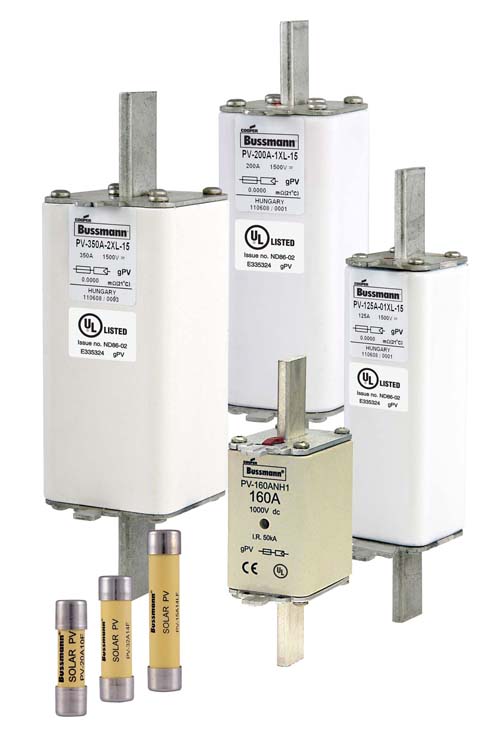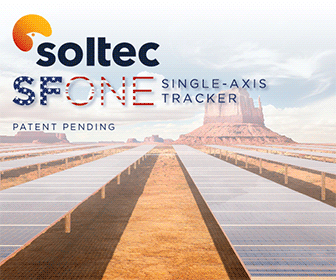Safeguarding Solar Energy Applications: With the right circuit protection
 Photovoltaic (PV) systems convert the energy of the sun into electrical power, which is then fed directly into the electric grid. Within the balance-of-system (BoS)—which comprises of the components that move the energy through the conversion system (the wiring, switches, battery, etc.)—over-current protective devices (OCPDs) protect the wiring connected from the modules to the combiner or the inverter. OCPDs are like a valuable security system, providing protection for solar BoS equipment and supporting uptime.
Photovoltaic (PV) systems convert the energy of the sun into electrical power, which is then fed directly into the electric grid. Within the balance-of-system (BoS)—which comprises of the components that move the energy through the conversion system (the wiring, switches, battery, etc.)—over-current protective devices (OCPDs) protect the wiring connected from the modules to the combiner or the inverter. OCPDs are like a valuable security system, providing protection for solar BoS equipment and supporting uptime.
An important component of PV systems, these protection devices have become one of the basic building blocks of solar power distribution systems, and include circuit breakers and fuses. With a comprehensive selection of circuit protection devices now available to choose from, however, the challenge is to determine which technology will provide the most benefit for specific solar applications—while meeting the applicable electrical industry and safety codes.
Protecting PV systems
Unlike typical grid-connected AC systems, the available short-circuit current within a PV system is limited. As a result, the OCPDs need to operate efficiently and effectively on low levels of fault current. For this reason, extensive research has been conducted to develop fuses and circuit breakers that are specifically designed and tested to protect PV systems with high DC voltages and low-fault currents.
The International Electrotechnical Commissions (IEC) and Underwriters Laboratories (UL) recognize that the protection of PV systems is different than conventional electrical installations. This is reflected in IEC 60269-6 (gPV) and UL 2579 for fuses and UL 489B for breakers, which define the characteristics an OCPD should meet for protecting PV systems (see sidebar).
Protecting PV source circuits
The Maximum-Power-Point (MPP) of modules of equal PV cell dimensions can vary as much as 35% between manufacturers. When selecting the appropriate fuses, the specified short-circuit current (Isc) and reverse current characteristics specified by the manufacturer should be used.
These specifications should always be consulted to confirm the module’s output amperage and voltage under the expected range of conditions for the proposed installation. Such conditions are influenced by the ambient temperature, by the sun’s incident angle, as well as by the amount of solar energy reaching the PV module. They are usually referred to as co-efficients on the specifications.
Most manufacturers also suggest a maximum series fuse rating or a reverse current rating. Both of these are based on PV modules withstanding 1.35 times this rating for two hours. Depending on the desired system capacity, there may be several PV strings connected in parallel to achieve higher amperage, and subsequently more power.
Systems that have less than three strings likely won’t generate enough fault current (short-circuit) to damage the modules, conductors, or downstream equipment. They don’t usually present a safety hazard, provided the conductor is correctly sized based on local codes and installation requirements. When three or more PV strings are connected in parallel, however, a fuse on each string can help protect the modules and conductors from over-current faults, minimizing any safety hazards. The fuse should also isolate a faulted string, so the BoS can continue to generate electricity.
It’s also worth noting that there is two different types of disconnect means: DC molded case switch (MCS) and the DC disconnect switch solutions. PV fuses are used for over-current protection in either case. MCS in a string combiner box can provide the dual function of a disconnect with remote OFF operation, which is suitable for meeting the NEC 2014 690.12 requirement for PV rapid shutdown.
Setting standards
Standards are important in most any industry to ensure quality and reliability, but particularly when it comes to safety and electrical devices. Here are the standards for PV fuses and switches.
Standards for PV fuses
- PV fuses should be fully tested to the requirements of IEC 60269-6 and exceed the requirements of operating at 1.45 times the nominal current. They should also meet the requirements of UL 2579;
- The current ratings are defined by the performance requirements of IEC 60269-6 and UL 2579 to protect modules during over-current situations. These IEC and UL ratings don’t reflect a continuous service rating. The assigned service rating should be reduced at increased ambient temperatures; and
- To ensure longevity, PV fuses shouldn’t be subjected to a continuous current of more than 80% of the assigned IEC and UL ratings.
Standards for PV molded case circuit breakers (MCCBs) & molded case switches (MCS)
- PV MCCBs and MCSs should be fully tested, while meeting and exceeding the requirements of UL 489B;
- The current ratings assigned to PV circuit breakers are defined by the performance requirements of UL 489B, so as to protect modules during over-current situations; and
- PV circuit breakers come in two application ratings: 80% and 100%. To ensure longevity, each rating should be properly applied. The total voltage of a solar module or array is determined by the number of individual cells connected in series, with each size usually between 4" and 6" square.
Protecting output circuits
Depending on a solar system’s capacity, there may be several output circuits (each output circuit consisting of multiple PV source circuits) connected in parallel to achieve higher ampacity and more power.
An OPCD on each output circuit serves to protect the conductors from fault currents, thereby helping to minimize any safety hazards. It can also isolate a faulted output circuit, ensuring the rest of the system continues to generate power without change.
The conductor, which carries the combined power output from a number of circuits, should also be protected by an OPCD. If a number of output circuits are combined prior to reaching the inverter, then an additional over-current protective device should be incorporated.
Module performance varies, depending on the temperature and the irradiance level. In operation, OPCDs are also influenced by ambient temperature, so de-rating should be factored in when being specified.
Understanding ratings
PV circuit breakers are available in 600 VDC and 1000 VDC models, with either 80% or 100% ratings. Understanding the difference between these circuit breakers is important. The major benefit of a 100%-rated circuit breaker is the ability to apply its full nameplate ampacity, thereby allowing for a reduction in its ampacity, frame size, conductor size, and often times the enclosure size.
Here’s a quick breakdown:
- A 80%-rated circuit breaker
Combine the total ampacity of the PV source circuits using a 1.56 de-rating factor (module Isc x 1.25 x 1.25 x number of strings in parallel)
- A 100%-rated circuit breaker
Combine the total ampacity of the PV source circuits using a 1.25 de-rating factor (module Isc x 1.25 x number of strings in parallel)
Fully understanding the complexity of right-sizing a circuit protection system and knowing how to choose from today’s broad selection of over-current solutions can help engineers better design a PV project’s power distribution system. Addressing potential safety issues, including equipment protection, as well as system reliability and efficiency from the start goes a long way to ensuring a solar farm’s longevity.
Jason Ezzell is a field applications engineer at Eaton, providing technical sales support for the southeast region of the US for Eaton’s Bussmann Business.
Eaton provides a broadest range of PV fuses and circuit breaker solutions, ensuring engineers have the flexibility to design the most effective solution for their application requirements.
Eaton
www.eaton.com/solar
Author: Ian Stuart
Volume: November/December 2014









.jpg?r=7923)

.jpg?r=1846)
.gif?r=2254)